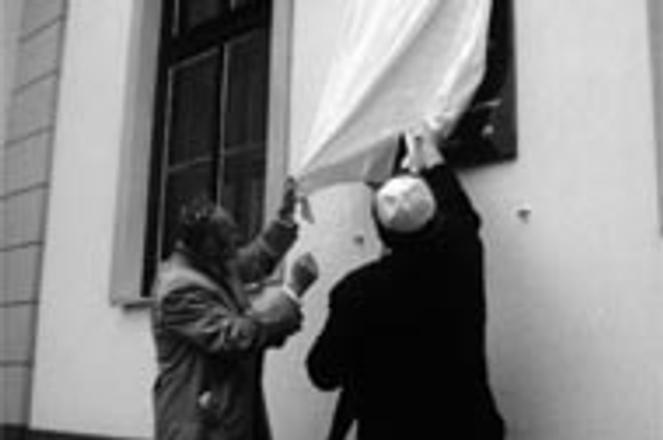The unveiling. Sir Sigmund Sternberg, and Professor Pavel Traubner lifted the cover off of a plaque honoring Raoul Wallenberg, who saved hundreds of jews in WWII.Terry Moran
Slovaks honored their own Oscar Schindler, although he was Swedish and in the tumultuous days of World War II he officially lived in Hungary.
A plaque in honor of Raoul Wallenberg, a Swedish diplomat who is said to have saved the lives of hundreds of Jews during World War II, was unveiled in the southern Slovak town of Nové Zámky on July 6.
The city has gone back and forth like a ping-pong ball between Slovakia and Hungary in this century, and during WWII it was on the Hungarian side of the border. The first deportations of Hungarian Jews to concentration camps started out from Nové Zámky on July 6, 1944. Had Wallenberg not been providing Swedish passports from Budapest in anticipation of this event, which started more than two years after Slovakia's deportations, the numbers would have been far greater, this community says.
Presiding over the unveiling outside the synagogue in Nové Zámky were Sir Sigmund Sternberg, Chairman of the International Council of Christians and Jews, and Professor Pavel Traubner, Honorary President of the Union of Slovak Jews. On behalf of his organization, based in London and active in 28 countries around the world in promoting tolerance and understanding, Sir Sigmund said that Wallenberg is "a symbol of the fact that even one person can make a difference."
Such tributes to Wallenberg have been delayed because of rumors that periodically arise that Wallenberg survived his captivity in Russia and has been seen alive. However, beginning in London last February (with Queen Elisabeth attending), they have started. The Wallenberg family, believing that he may still be alive, however, has requested that they be commemorative rather than memorial tributes.
The event brought together several diplomats and other dignitaries, including Ruben Kemeny, the Swedish honorary consul to Slovakia, Yoel Sher, the Israeli ambassador to Austria, Slovenia and Slovakia based in Vienna, Jenő Boros, the Hungarian ambassador to Slovakia, and Tomas Kaufman, a former Slovak colleague of Wallenberg's. They all braved the lashing rain to praise Wallenberg.
Kaufman, a Slovak-Hungarian from Bratislava, was 16 at the end of WWII. He found refuge as an employee of the Swedish Embassy and helped Wallenberg, the second vice-consul at the Embassy, prepare the yellow Swedish passports for Jews fleeing Hungary. Kaufman said it was possible for non-Swedes to be granted Swedish passports under special circumstances.
He continued that Wallenberg made contacts among the highest ranking SS members in Budapest, knowing that he could wield more influence in helping people escape. When the Russians took over the city in 1945, these contacts gave them a pretext for arresting him, and Wallenberg was never officially heard from again.
Despite great attention from diplomatic community, the tribute was not a celebrity-only event. Michael Garay was 17 at the time. He was back in Nové Zámky for the azkara (commemoration) and to ask questions about some 20 Jews who were reportedly forced to dig their own graves and shot in front of the Jewish cemetery in Nové Zámky weeks after the war was seemingly over in 1945. Garay was told the murderers are believed to have been wearing the Arrow Cross of the Hungarian Nazis, but they could also have been Slovaks.
Garay, who belongs to those southern Slovaks who feel equally Slovak and Hungarian, was deported from Nové Zámky one year before the incident. He spent the next two years in Auschwitz and later in the Dachau concentration camp. Like most Jews from the region, his immediate family members perished in the camps. He lives today in Tucson, Arizona.
In paying tribute to Wallenberg, Sir Sigmund touched upon the controversial history book by Milan Ďurica, which attempts to whitewash Slovakia's role in the persecution of Jews.
And during the presentation of the Interfaith Good Medallion to President Michal Kováč on July 7, he added that "it is with concern that we learned, at the very same time we were unveiling the [Wallenberg] plaque, a tribute to the late President [Jozef] Tiso was erected in the town of Čajakovce."

